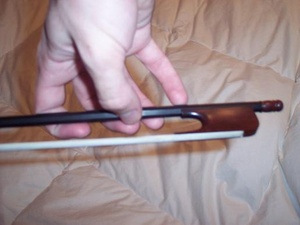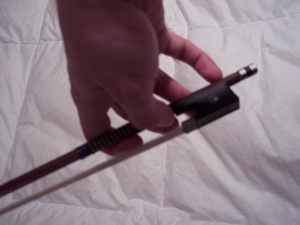The Music Department maintains several period instruments. Most are replicas, some fashioned by ensemble member Devin Hough, a violist and luthier. He has crafted violins, violas, viola da gambas, viola da morea, and several bows. The examples shown below are violins from the private collection of AndrewBanta and are not from the University collection. However, when an opportunity arises for a photo session of the actual instruments the university owns, replacements will be posted.
Baroque
Violins
Violins of the Baroque period differ in construction from most contemporary violins. As far as playing goes, the most diffucult hurdle to jump would be how the violin itself is actually held.
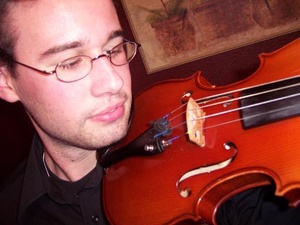 the Modern violin held on the left side of the tailpiece
the Modern violin held on the left side of the tailpiece
In modern times, with the advent of the chin rest, the violinist holds the violin on the "left" side of the tail piece. This puts the violin at a dramatic angle and projects the soundwaves more laterally, and less vertically.
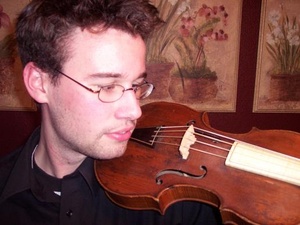 the Baroque violin held on the right side of the tailpiece
the Baroque violin held on the right side of the tailpiece
However, in the Baroque, the violin is held on the opposite side of the tailpiece. Some musicians even use the tailpiece itself as a sort of "chinrest." The violin is much "flatter" this is to say it is nearly parallel to the ground. A good deal of the holding is done with the left hand, instead of the chin, as would be done in modern times. The bow simply resting on the violin also helps keep it in place. Most of the structural differences between Baroque violins and contemporary violins can also be applied to cellos and violas and basses of the time period. Note: Stylistic variations between makers are great; definite differences exist between Italian and German violin workshops in particular, while an Italian violin is prone to a "bright" piercing sound, a German instrument is apt to have a deeper, darker timbre.
 Baroque violin neck, note the 'wedge' shape of the finger board
Baroque violin neck, note the 'wedge' shape of the finger board
The neck of the Baroque violin is slightly shorter. It is attached at a right angle to the body, with no backwards slope. It is thus necessary to have a "wedge" shaped fingerboard. The fingerboard may be made of maple, and in some cases ornamented with purfling. Some makers use spruce as the main wood, covering with a thin veneer of (rare/expensive) ebony to reduce weight and cost of the finished instrument.
The strings for Western instruments are made from the small intestines of lamb. Eastern instruments such as those in India, and perhaps Asia, use horse hair.
The strings attach to pegs located in the pegbox at the end of the neck, they travel down the fingerboard, and over the bridge, and finally end at the tailpiece where the are fed through small holes and knotted at the end. The bridge is actually a floating structure, held in place simply by the "downward" force of the strings.
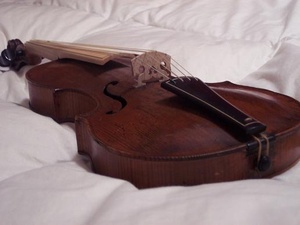 view of a Baroque violin bridge
view of a Baroque violin bridge
 view of a modern violin (left) & a Baroque violin (right) in profile
view of a modern violin (left) & a Baroque violin (right) in profile
Baroque bridges are flatter than modern and more ornate. Other than that they are not too notable. The tailpiece is a simple structure with six holes, four for the strings themselves, and two additional holes at the base through which a large gauge piece of gut is run, and wraps around a "saddle" and finally attaches to the end button. Other differences between Baroque and contemporary instruments include the bass bar and the soundpost, both of which are inside the body of the instrument, and will not be discussed due to the complexity of their nature, not the simplicity of design.
The strings attach to pegs located in the pegbox at the end of the neck, they travel down the fingerboard, and over the bridge, and finally end at the tailpiece where the are fed through small holes and knotted at the end. The bridge is actually a floating structure, held in place simply by the "downward" force of the strings. Baroque bridges are flatter than modern and more ornate. Other than that they are not too notable. The tailpiece is a simple structure with six holes, four for the strings themselves, and two additional holes at the base through which a large gauge piece of gut is run, and wraps around a "saddle" and finally attaches to the end button. There are other differences between Baroque and contemporary instruments include the bass bar and the soundpost, both of which are inside the body of the instrument, and will not be discussed due to the complexity of their nature, not the simplicity of design.
Bows
Another aspect to Baroque performance is the bow. Bows of the Baroque are lighter and in many cases shorter. They have a thinner band of hair and have a much lighter touch, due to the overall weight. Bows either employ a screw tightener or a clip in-style frog, often referred to as a "Corelli clip-in style frog." The frog is basically a way to adjust the tension of the bow-hair. In the picture of the three bows note the points of the bows, most Baroque bows are shorter as the first, but there are long bows as well. Also note the tips of the bows.
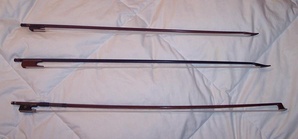 From top to bottom: Short 'Italian' style bow, Long bow, Modern bow, note the grip
From top to bottom: Short 'Italian' style bow, Long bow, Modern bow, note the grip
Cellos
Baroque cellos have one distinct difference from modern cellos: there is no end pin on a Baroque cello. That means the instrument is saddled, this is not a balancing act, for the instrument is held with the slightest of muscle action, on the player's calves. The cello's lower ribs rest on the calves, this has nothing much to do with the thighs, and the back of the instrument lies more or less on the players chest. Shifting for cellist is not inhibited in the manor that it would be for violinists. The instrument remains rather stable. However, for the modern cellist the difficulty comes in having the entire cello physically higher than it would be were he/she using an endpin. Some cellists of the Baroque used small boxes to rest the instrument upon.
Harpsichords
A harpsichord sounds by plucking the the strings, in response to a key strike from the manual (commonly referred to as the keyboard). In contrast, piano strings are struck by hammers. The significance of this is that there is no volume control on the harpsichord, at least not in the sense we think of. Volume is controlled by the "density" of the chords, basically how many notes you choose to play at once. Also there are couplers that cause two sets of identically tuned strings to be plucked at once, thus doubleing the volume. In contrast the piano permits volume control by pressing the keys with greater force, or perhaps less force (force is proportional to volume). Piano is a shortening of "piano-forte" (in modern times, the original name for the instrument was "forte-piano), which means "soft-loud". The piano mechanism is complex; the keys ballistically "launch" the hammers at the strings,in this way the hammer rebounds off the string quickly so as not to dampen the vibration. Harpsichords are notable for their finicky disposition, and harpsichordists are always rather particular about the "action" of the manual. The harpsichordist is to a Baroque ensemble as a pianist is to a Jazz Band. They both improvise off a figured bass—they don't usually have a written out part. They have quite a bit of freedom in the group. The harpsichord is part of the basso continuo or "continuous bass". This section is usually made up one ore more of the bass instruments, ie. cello, bass, lute, and/or harpsichord. Baroque ensembles tended to be small.


